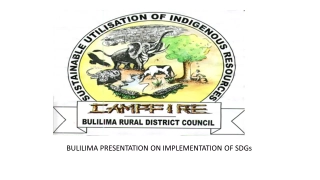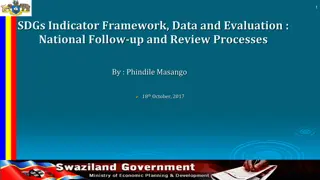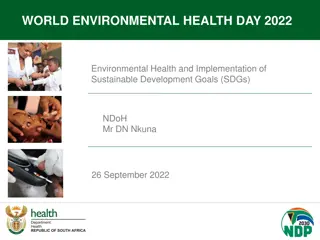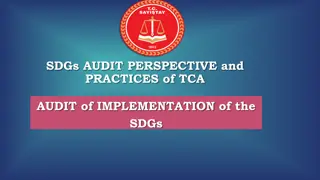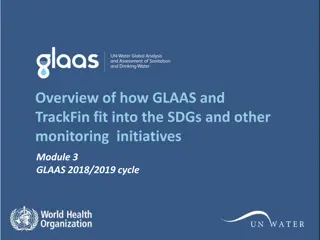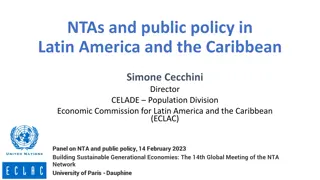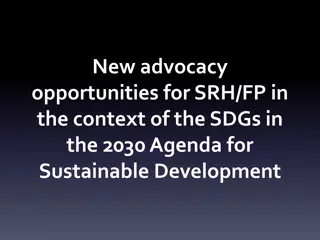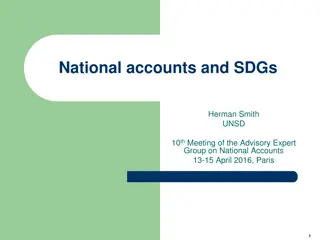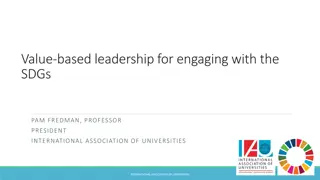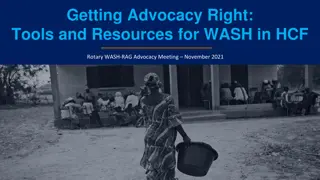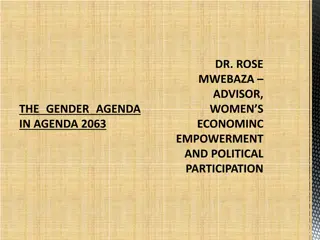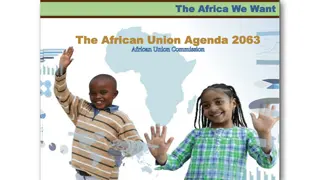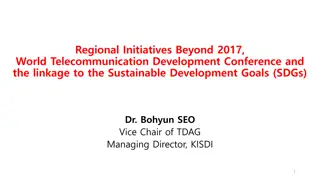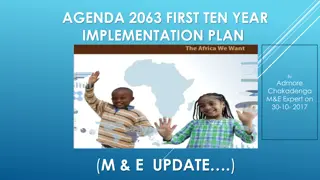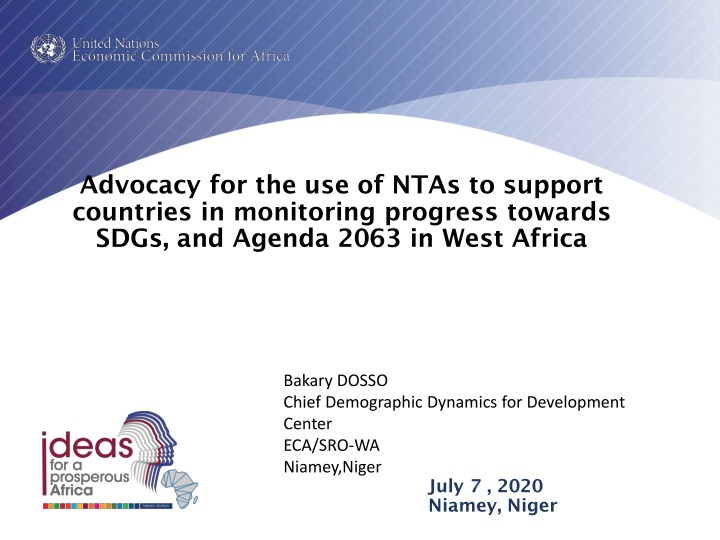
Advocacy for NTAs in Monitoring SDGs & Agenda 2063 in West Africa
Advocating for the use of National Translation Assistants to support countries in monitoring progress towards Sustainable Development Goals (SDGs) and Agenda 2063 in West Africa. This includes insights on demographic dynamics, ECOWAS statistics, demographic dividend, ongoing regional initiatives, and the upcoming ECOWAS Vision 2050. Explore how data frameworks are crucial for population analysis and economic growth potentials.
Download Presentation

Please find below an Image/Link to download the presentation.
The content on the website is provided AS IS for your information and personal use only. It may not be sold, licensed, or shared on other websites without obtaining consent from the author. If you encounter any issues during the download, it is possible that the publisher has removed the file from their server.
You are allowed to download the files provided on this website for personal or commercial use, subject to the condition that they are used lawfully. All files are the property of their respective owners.
The content on the website is provided AS IS for your information and personal use only. It may not be sold, licensed, or shared on other websites without obtaining consent from the author.
E N D
Presentation Transcript
Advocacy for the use of NTAs to support countries in monitoring progress towards SDGs, and Agenda 2063 in West Africa Bakary DOSSO Chief Demographic Dynamics for Development Center ECA/SRO-WA Niamey,Niger July 7 , 2020 Niamey, Niger
Population o 397.2 millions in 2020 as 29.6% of Africa o Under 15: 43.2% & Youth 15-24: 19.7% o Growth rate: 2.7% in 2015-2020 o In 2018, ECOWAS accounts for 26.3% of Africa's GDP. o Real GDP growth rate: 3.8% vs 2.7% for Africa in 2010-2018 o Budget balance excluding grants ranges from -2 % (BF) to -11.5% (GB) of GDP in 2019 Demographic transition not completed TFR in 2015-2020 o from 2.29 (Cabo Verde to 6.95 (Niger) o Average : 5.18 while 4.44 (Africa) Low structural transformation o weak structural transformation based on raw materials o Huge Social Demand Low Level of skills and insufficient human resources of sufficient quality o Inadequacy of programs curricula to labor market needs o Vulnerable Employment : 78.6% (ECOWAS) vs 44.6% (World) in 2019 o o Fragile States (Terrorism in BF, Mali, Niger, igeria) o Weaknesses of Governance Indicators (WGI) o High incidence of poverty rate
ECOWAS Vision 2020 and Human Capital We envision by 2020 - An inclusive society achieved through human capital development and empowerment, and offering a peaceful and healthy environment where women, children and youth thrive and have equitable access to resources and opportunities social cohesion that assures these hitherto vulnerable groups their rightful place in society
Demographic dividend defined as Economic growth potential that can be realized when the increase in the working age population is transformed into human capital which participates in the production. The contribution of human capital to growth is the combined effect of investment in education and health, a youth employment policy and good governance Progress towards the SDGs and Agenda 2063 is correlated with demographic dynamics
Ongoing Regional initiatives and the upcoming ECOWAS Vision 2050 National demographic dividend observatories implemented with the financial and technical support of SWEDD, UNFPA and CREG. A national Budgeting framework sensitive to Demographic Dividend rolled out in Mali with the support of the ECA and CREG Advocacy for demo-economic data collection, analysis and dissemination with the support of ECA
Regional ECOWAS Profile ECOWAS AVERAGE PROFILE ECOWAS AGREGATE PROFILE 2014 30.000 Age: 31 10000 25.000 8000 20.000 Billions USD 6000 Age: 62 USD 15.000 4000 10.000 US$ 566.46 Bn 2000 5.000 0 0.000 28 14 21 35 42 49 56 63 70 77 84 0 7 10 15 20 25 30 35 40 45 50 55 60 65 70 75 80 85 0 5 90+ Age Age C YL C YL Summary (Amount in Billion USD) Summary (Amount in Billion USD) Youth (0- 30 years) Old (63 years and +) Surplus (31 - 62 years) Life Cycle Deficit Global (LCD) Life Cycle Deficit Global (LCD) 566.464 20.745 173.731 413.478 413.478 28.6% of GDP 28.6% of GDP 96.5% 3.5% Life Cycle Deficit (LCD) Source: CREG & ECA, 2020
Synthesis of average profile of subregions 8000 7000 6000 5000 4000 3000 2000 1000 0 24 56 88 12 16 20 28 32 36 40 44 48 52 60 64 68 72 76 80 84 0 4 8 C_MRU YL_MRU C_GG YL_GG C_Sahel YL_Sahel C_SENGMB YL_SENGMB Synthesis of average profile of consumption of subregions Synthesis of average profile of income of subregions 5000 8000 4000 6000 3000 4000 2000 2000 1000 0 0 55 55 70 10 15 20 25 30 35 40 45 50 60 65 70 75 80 85 10 15 20 25 30 35 40 45 50 60 65 75 80 85 0 5 0 5 90+ 90+ C_MRU C_GG C_Sahel C_SENGMB YL_MRU YL_GG YL_Sahel YL_SENGMB Source: CREG & ECA, 2020
Projections of DD for ECOWAS by TFR scenarios 0.90 2040 0.80 2045 0.70 0.60 2055 0.50 0.38 0.40 0.31 0.30 0.20 0.24 0.23 0.10 0.00 2015 2020 2025 2030 2035 2040 2045 2050 2055 2060 2065 2070 2075 2080 2085 2090 2095 DD_low-TFR DD_med_TFR DD_High_TFR Source: CREG & ECA, 2020
Key messages Economic variables are age dependents. Economic lifecycle deficit (LCD) is an excellent indicator of the social demand. ECOWAS generations run lifecycle surpluses between ages 31 and 62 and the LCD represents 28.6% of the GDP of the region. The window of opportunity of the DD in West Africa will reach the maximum in 2045. The region should implement structural policies to create decent jobs for youth (economic and structural transformation). Prepare population aging from 2045. Collection of demo-economic data in West Africa required major data collection operations (GPHC, EDS, Survey on Household Living Conditions, Population Registers Operation Systems, System of National Accounts, Education, Health, Environment, Migration etc.). Most of those operations are conducted irregularly. As a result, several important aspects of the DDDs are poorly or not covered by official statistics.
Policy recommandations Policy dialogue with the ECOWAS Commission to ensure that the Vision 2050 is informed by the findings of available knowledge on population dynamics Advocate for the establishment of a DD monitoring programme by the ECOWAS Commission Advocate for the use of NTA indicators in the ECOWAS regional Convergence Report as indicator of social integration in West Africa (Life cycle deficit, Economic Support Ratio, etc) Build capacity of national statistical offices and advocate for regular production of the data ecosystem needed for the production of national and regional NTA profiles

